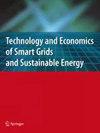Reactive Power Sharing Among Distributed Generation Sources in Islanded Microgrids to Improve Voltage Stability
IF 1.5
Q4 ENERGY & FUELS
Technology and Economics of Smart Grids and Sustainable Energy
Pub Date : 2023-10-07
DOI:10.1007/s40866-023-00172-3
引用次数: 0
Abstract
Extensive use of distributed generation (DG) resources in distribution systems and uncertainty of the daily active power of these sources have caused the connection bus voltage to deviate from the allowable limit. DG reactive power control is of one the solutions for this problem. The purpose of this paper, in addition to controlling the bus voltage, is to share reactive power between the DG resources and to maintain the maximum active power level produced by the DGs. Reactive power sharing issues are unavoidable due to the difference in impedance of the DGs feeders and the different classifications of the DG units in the conventional drop control scheme. In this paper, reactive power sharing among generation resources are used to improve voltage stability. Virtual impedance method has also been used as one of the methods of reactive power sharing between sources to show and compare reactive power sharing methods between DG sources. In order to show the voltage improvement in this paper, the stability index L_index has been used. The proposed L_index has been confirmed against the existing methods for evaluating voltage stability using the reactive power sharing method in this study. This study is carried out in conjunction with an islanded microgrid model IEEE 38-BUS, the voltage stability of the corresponding microgrid buses has been shown. Voltage stability is achieved by reactive power sharing among distributed generation sources and is demonstrated in this study.孤岛微电网分布式发电源间无功共享提高电压稳定性
由于配电系统中分布式发电资源的大量使用以及分布式发电日有功功率的不确定性,导致接线母线电压偏离允许限值。DG无功控制是解决这一问题的方法之一。本文的目的除了控制母线电压外,还在于在DG资源之间共享无功功率,并保持DG产生的最大有功功率水平。由于传统液滴控制方案中液滴馈线的阻抗差异和液滴机组的不同分类,无功功率共享问题不可避免。本文采用发电资源间无功共享来提高电压稳定性。虚拟阻抗法也被用作源间无功分担的方法之一,用以展示和比较DG源间无功分担的方法。为了体现电压的改善,本文采用了稳定性指标L_index。本文提出的L_index与已有的无功分担法电压稳定性评价方法进行了对比验证。本研究结合孤岛微电网模型IEEE 38-BUS进行,显示了相应微电网母线的电压稳定性。电压稳定是通过分布式发电源之间的无功功率共享来实现的,并在本研究中得到了验证。
本文章由计算机程序翻译,如有差异,请以英文原文为准。
求助全文
约1分钟内获得全文
求助全文
来源期刊

Technology and Economics of Smart Grids and Sustainable Energy
Economics, Econometrics and Finance-Economics and Econometrics
CiteScore
3.90
自引率
18.20%
发文量
33
 求助内容:
求助内容: 应助结果提醒方式:
应助结果提醒方式:


